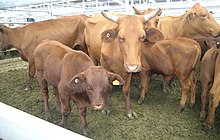King Ranch
Both served under General Zachary Taylor (later the 12th US president), operating steamboats from Brazos Santiago Harbor in Texas, USA, to Matamoros in Mexico, and on up river to Camargo, Tamaulipas, in support of the U.S. invasion of Monterrey and Saltillo.
During the American Civil War, the steamboat fleet was reflagged under the name of the Matamoros, Mexico citizen Francisco Iturria and the Mexican flag.
As Mexico was a neutral country, the steamboats could not be stopped by Union blockaders, and engaged in a lively commerce of transporting Texas cotton to many deep-water ships anchored offshore Matamoros, on the Mexican side of the Rio Grande.
After a grueling ride, King caught sight of the Santa Gertrudis Creek, 124 mi (200 km) from the Rio Grande.
The land, which was shaded by large mesquite trees, so impressed him, when he arrived at the fair, he and a friend, Texas Ranger Captain Gideon K. "Legs" Lewis, agreed then and there to make it into a ranch.
During this time, Richard King purchased the Rincón de Santa Gertrudis grant, a 15,500 acres (63 km2; 24.2 sq mi) holding that encompassed present-day Kingsville, Texas.
At the same time, Lewis sold King undivided half-interest in the ranchos of Manuel Barrera and of Juan Villareal for the same sum, on November 14, 1853.
As the years passed, more land was added, growing to 1.2 million acres (1,875 sq mi, 4,900 km2) at its largest extent, until reaching its current total.
[2] On July 1, 1856, a court sale of Lewis' property (including the undivided half-interest in the land of the Ranch) was held.
King thus retained operational control of the Ranch, with Walworth as a silent partner who held title to the land, and who paid taxes on it.
King thus returned to Cruillas and offered the villagers the opportunity to work for him, in exchange for food, shelter, and income.
Lea portrays King's purchase of the Ranch as motivated by his wooing of Henrietta Maria Morse Chamberlain (1832–1925), whom he married in the First Presbyterian Church, Brownsville, on Sunday, December 10, 1854.
During the United States Civil War, the disruption of the flow of cattle to market initially caused a drop in beef prices.
To handle depredations (rustling), the ranchers formed the Stock Raisers Association of Western Texas in 1870; Mifflin Kenedy led the first meeting.
Upon the sale of the herd to the northern buyers, the trail bosses could relieve their indebtedness, and earn a profit greater than their ordinary wages.
"[7] By 1929, the taxes ($859,000) had been paid up, in installments, but the trustees had to borrow money, so by the market crash of 1929, Henrietta King's estate was in debt $3,000,000.
[12] Humble Oil loaned enough money to pay the debts of the H.M. King estate, secured by a first mortgage on the land.
On November 18, 1936, Luther Blanton and his son, John, trespassed on the ranch by crawling through the fence surrounding it.
Although most residents suspected them being murdered by ranch guards for trespassing, it remains a long-standing unsolved mystery.
They include dark brown leather seats, and the badges show the King Ranch 'Running W' brand.
[20] Edna Ferber's novel Giant, which was turned into a film of the same name, takes place on King Ranch.
[citation needed] The historical fiction novel Lords of the Land by Matt Braun is based on the King Ranch and its founder, although names and some circumstance have been altered.
[citation needed] A cowboy's perspective on the King Ranch subsidiary in Australia, the cattle station Brunette Downs, is captured in the 2012 autobiography by Nick Campbell-Jones Don't Die Wondering.
Campbell-Jones was a jackaroo (Australian cowboy) who started at Brunette Downs in 1963 and worked his way up to overseer and assistant manager before leaving in 1975.

